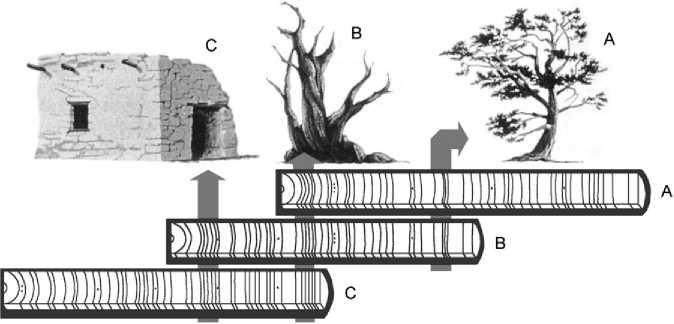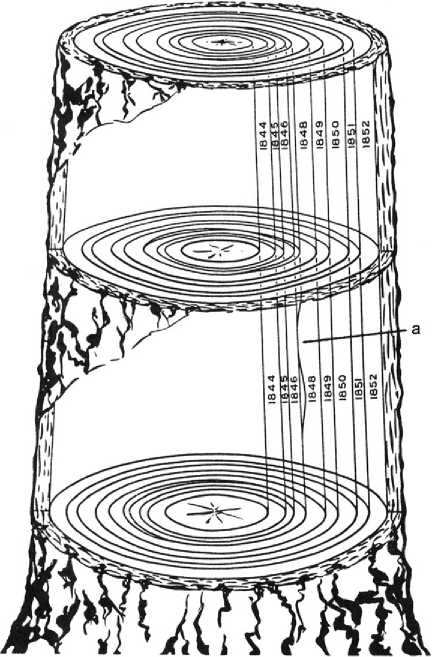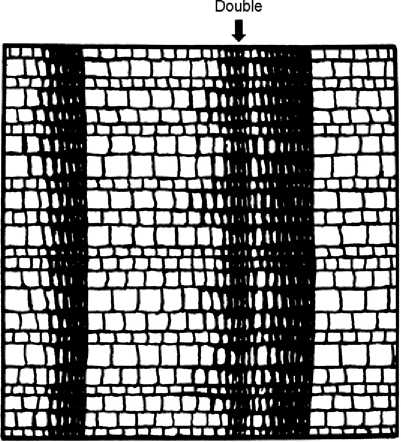Four conditions must be fulfilled before dendrochronology may be developed and applied in archaeological research. The first condition is that the tree species under analysis produce only one growth ring per calendar year. Unfortunately, nature is not always so neat. During particularly stressful years, trees that usually produce one growth ring per year may actually fail to produce a growth ring, in which case den-drochronologists will note a 'missing ring’ (or ‘locally absent ring’) in its tree-ring sequence (Figure 2). Some species, such as pinyon (Pinus edulis), may present many missing rings in any given sequence and therefore must be crossdated with extreme care. If missing rings are not properly identified through crossdating, the dendrochronologist may assign a tree-ring date to the last growth ring on the specimen that is ‘too old’ on the common-era calendar.
Under other stressful conditions, trees that typically produce one growth ring per year may in fact produce two or more rings in a given year (Figure 3). ‘Double rings’ are created when climatic conditions (e. g., drought or cold snap) prompt a tree to stop growing prematurely, then to resume growth when favorable conditions return later that growing season. If not properly identified and crossdated, double rings will cause the dendrochronologist to assign a common-era calendar date that is too young.
The potential for missing, locally absent, and double rings varies by tree species and location, and are the reasons that the basic principle of dendrochronology, crossdating, requires so much more than simple ring counting. It is essential to all archaeological treering dating that the dendrochronologists use crossdating to identify all problem rings before assigning dates to a tree-ring chronology. Once a sound treering chronology has been properly crossdated, the act of deriving a tree-ring date for an archaeological wood or charcoal specimen requires controlled comparison of the ring sequence for that specimen against the master chronology derived for that region.

Figure 1 Crossdating, the procedure of matching patterns in annual variations in ring width (or other ring parameters, including density) from specimen to specimen, working back through time. Note that crossdating is not ring counting. (Figure courtesy of the Laboratory of Tree-Ring Research, The University of Arizona, Tucson).

Figure 2 Missing (or locally absent) rings. If a tree-ring core were taken at the radius marked by line a, the growth ring for AD 1447 would not be present on that core, and would be identified through crossdating with other specimens in which the growth ring for that year is present. In the strictest terms, the growth ring for AD 1447 is locally absent, as it is present on certain portions of the tree stem. (Figure courtesy of the Laboratory of Tree-Ring Research, The University of Arizona, Tucson).

Figure 3 Double rings are caused by some environmental stress, like a cold or dry period, which causes a tree to prematurely begin growth cessation and the creation of darker latewood cells. With the return of normal growing conditions, growth, and the production of earlywood resumes, until the end of the growing season and the creation of a normal ring boundary (Figure courtesy of the Laboratory of Tree-Ring Research, The University of Arizona, Tucson).
The second prerequisite condition for successful crossdating is that growth of the tree species under consideration be limited primarily by one environmental factor. In the American Southwest and at lower elevation tree lines, that environmental factor is usually precipitation. In Europe, at upper tree lines, and in high latitudes, that environmental factor is usually temperature. Research (and common sense) has of course demonstrated that many parameters, including environmental, genetic, and idiosyncratic variables, affect individual tree growth. For tree ring dating to work, however, a climatic variable must be most responsible for tree-growth variation in the species being examined in any given area. If this is the case, it can be stated that the trees in that area are responding to the same ‘climate signal’.
The third prerequisite condition for successful crossdating requires that the growth-limiting factor (be it temperature or precipitation) be characterized by extreme annual variability and that the variability is then recorded in growth rings of trees in the area. That is, the trees must be ‘sensitive’ to the local climate signal. To belabor the point: Because crossdating requires ring-width pattern matching, there has to be environmentally produced and variable ring-width patterns available to crossdate! Trees that are not stressed and indeed enjoy growing conditions favorable to growth (look at cross sections in your local lumber yard) produce annual rings that are comparatively uniform in width and therefore have a uniform pattern. Such ring series are termed ‘complacent’ and are not ideal for dendrochronological analysis.
The fourth prerequisite condition for successful crossdating requires that the variability in the climatic parameter to which the trees are responding be geographically extensive and influential enough that trees across a large region respond to that variability in similar fashion. On the Colorado Plateau, in the Four Corners region of the American Southwest, for instance, coniferous tree species generally respond to a plateau-wide climate (e. g., precipitation) signal even though much more localized variability is also recorded by the trees.
For archaeological dating to be possible at all, two additional conditions must be met. The first is a function of prehistoric wood use behavior. Though it may seem obvious, it is worth stating: If prehistoric populations did not make use of crossdatable tree species for firewood, as construction timbers, or as raw material for artifacts, then it will be impossible to treering date their sites, features, and objects because the wood and charcoal recovered by archaeologists is not, by definition, datable. For example, cottonwood and ironwood are two tree species available to prehistoric inhabitants of the American Southwest but for which tree growth violates one or more of the aforementioned prerequisite conditions. Cottonwood and ironwood simply do not produce annualized rings that are sensitive to individual climate signals. If the prehistoric inhabitants of the American Southwest built their houses with cottonwood logs and cooked their food over ironwood campfires, dendrochronol-ogists would simply not be able to date prehistoric sites using tree-ring analysis. Fortunately for archaeologists, the prehistoric inhabitants of the Four Corners region made extensive use of crossdatable species like ponderosa pine, Douglas fir, pinyon, and juniper.
A second additional condition, corollary to the first, is that, even if prehistoric populations made use of crossdatable tree species, tree-ring dating is possible only if samples remain preserved in the archaeological record, in the form of wood or charcoal, and are recovered, saved, and submitted for analysis by archaeologists. Thirteenth-century cliff dwellings in the American Southwest, such as those at Mesa Verde, are well-dated dendrochronologically because wood beams have been preserved in the dry rockshelter environments and remain to be sampled by archaeologists today. On the other hand, tenth-century open-air sites and pit structures in the Southwest are not well-dated because wood samples decay in open-air environments, though charcoal can remain in good condition for comparatively long periods of time in such environments.
The principle of crossdating and the prerequisite conditions for archaeological tree-ring dating are invariable. Accurately crossdated tree-ring chronologies cannot be developed if any of the first four above conditions are not met, and archaeological artifacts, features, and sites cannot be tree-ring dated if appropriate tree species were not used prehistorically and are not preserved for recovery today.




 World History
World History









